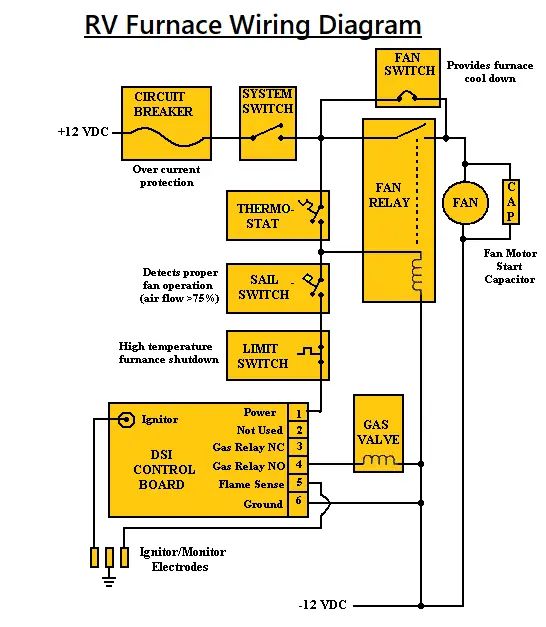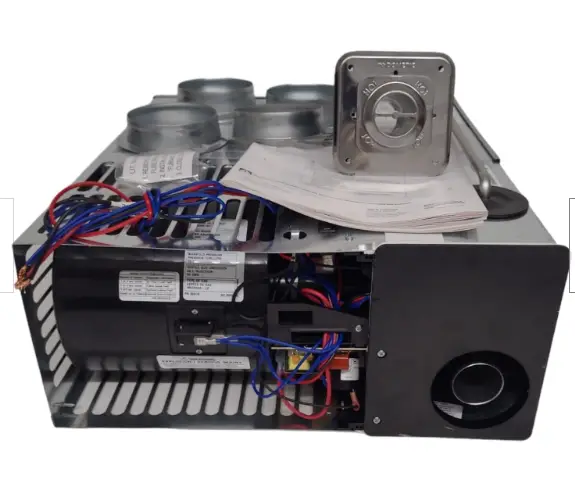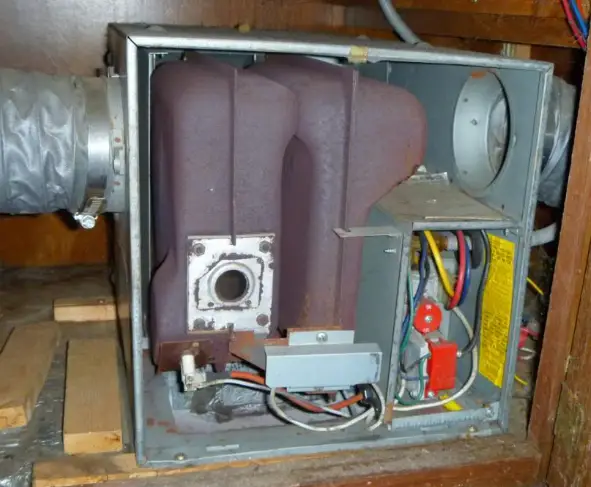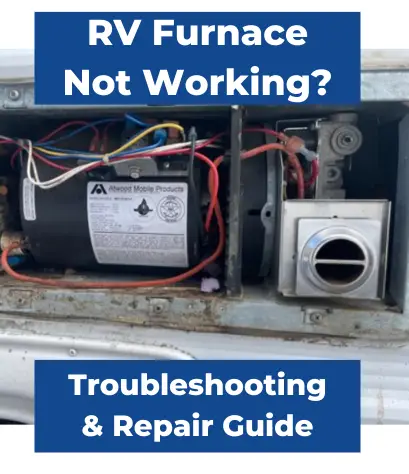Let’s face it: it can be a frustrating and uncomfortable experience if you’re in a situation where your RV furnace is not working The furnace is an essential component of the RV heating system, and it’s crucial to keep it in good working order. There are several reasons for an RV furnace not working, and it’s essential to troubleshoot the issue to determine the cause.
Like most things involving RV’s, the solution may be simple but will require some investigating and trying out a few things to nail down exactly what the problem and solution is.
Don’t worry! We’ll guide you through how to get your RV furnace back up and running in no time in this guide. Read on to learn all about it.
How Does an RV Furnace Work?
An RV furnace provides heat for the interior of the RV, allowing for comfortable living conditions in cold weather. Understanding how an RV furnace works can help you troubleshoot any problems that may arise.
The RV furnace is typically powered by propane, which is stored in a tank on the RV. The propane is fed into the combustion chamber where it is ignited by the igniter. The combustion process produces heat, which is then transferred to the heat exchanger.
The heat exchanger is a series of tubes that are heated by the combustion process, and it transfers the heat to the air that is blown into the RV by the blower/fan.
The blower/fan is powered by direct power, typically 12-volt DC, and it blows the heated air into the RV through ductwork. The blower/fan also draws in cool air from the RV and blows it over the heat exchanger to be heated. This process continues until the desired temperature is reached.
It is important to note that the RV furnace requires a steady supply of propane and a functioning igniter to operate. If either of these components is not working correctly, the furnace will not produce heat.
The blower/fan requires direct power to operate, so a dead battery or faulty electrical system can also cause issues with the furnace.
Here’s a good video showing how to operate and maintain an RV furnace:
What Are RV Furnace Diagnostic Codes?
When an RV furnace is not working properly, it can be difficult to determine the root cause of the problem. Fortunately, many RV furnaces are equipped with diagnostic codes that can help identify the issue.
These codes are designed to provide information about specific problems within the furnace’s control circuit board.
Diagnostic codes are typically displayed on the furnace’s control board or by a series of flashing lights, which are located on or in the furnace. The specific codes used can vary depending on the brand and model of the furnace.
When a diagnostic code is displayed, it is important to consult the furnace’s manual to determine the specific problem and the steps necessary to resolve it. In some cases, it may be necessary to replace a faulty component, such as a blower motor or pressure switch.
It is important to note that diagnostic codes should not be used as the sole means of troubleshooting an RV furnace. In some cases, the problem may not be related to a specific code and may require further investigation.
Also, some codes may be related to multiple issues, so it is important to consider all possible causes before making any repairs.
RV Furnace Wiring Diagram
When an RV furnace is not working, one of the possible causes could be related to the wiring or circuit board. Understanding the wiring diagram can help with troubleshooting and identifying any potential issues.
The RV furnace wiring diagram typically includes the following components:
- Thermostat: The thermostat controls the temperature and communicates with the furnace to turn it on and off as needed.
- Blower Motor: The blower motor is responsible for circulating the hot air throughout the RV.
- Igniter: The igniter is responsible for lighting the propane or gas to create heat.
- Gas Valve: The gas valve regulates the flow of gas to the furnace.
- Circuit Board: The circuit board is the brain of the furnace and controls all of its functions.
Here’s a typical RV Furnace Wiring Diagram for reference:

Make sure you have a multimeter on hand when checking wiring. This tool can help determine if there are any breaks or shorts in the wiring. It’s also important to check the connections and make sure they are tight and secure.
The circuit board is another potential area for issues. If the furnace is not working properly, it’s important to check the circuit board for any signs of damage or corrosion. If the circuit board needs to be replaced, it’s important to ensure that the replacement is compatible with the specific model of furnace.
Overall, understanding the RV furnace wiring diagram can help with troubleshooting and identifying any potential issues related to the wiring or circuit board. If there are any doubts or concerns, it’s best to consult with a professional for assistance.
The Top 4 Reasons Why An RV Furnace Is Not Working
When it comes to RV furnace issues, there are a few common reasons why it may not be working correctly. In this section, we will explore the top 4 reasons why an RV furnace may not be working and how to troubleshoot them.
You Turn Up Your RV’s Thermostat and Nothing Happens
If you turn up your RV’s thermostat and nothing happens, there are a few possible causes. First, check the power supply. Inadequate power supply can prevent the furnace from turning on. If the power supply is not the issue, it could be a bad relay for the blower motor. Check the relay and replace it if necessary.
Check out our guide to Troubleshooting A Dometic RV Thermostat
Bad Gas Valve
If your RV furnace is not producing heat, a bad gas valve could be the issue. Check the propane source and ensure it is functioning properly. If the propane source is not the issue, check the gas valve. If the gas valve is faulty, it will need to be replaced.
See Related: Switch RV Water Heater From Propane To Electric
RV Furnace Fan Runs But There’s No Heat
If the RV furnace fan is running but there is no heat, there are a few potential issues. First, check the fuel source (propane) and ensure it is functioning properly. If the fuel source is not the issue, it could be a sail switch failure. Check the sail switch and replace it if necessary.
See A Deeper Dive: How To Fix RV Heater Blowing Cold Air
Your RV Furnace Ignites and Produces Heat But Shuts Off Prematurely
If your RV furnace ignites and produces heat but shuts off prematurely, there are a few potential issues. First, check the high-level switch and ensure it is functioning properly. If the high-level switch is not the issue, it could be a faulty flame sensor. Check the flame sensor and replace it if necessary.
In summary, when troubleshooting an RV furnace, it is important to check the power supply, propane source, sail switch, high-level switch, relay for the blower motor, and flame sensor. By identifying the issue and taking the necessary steps to repair or replace the faulty component, you can ensure your RV furnace is functioning properly and keeping you warm on your travels.
Other Reasons Your RV Furnace Isn’t Working

If your RV furnace isn’t working, there could be a variety of reasons why. In addition to insufficient battery voltage and dirty air filters, there are other factors that can cause your RV furnace to stop working. Here are some other possible reasons:
Incomplete Combustion
Incomplete combustion can occur if there is a lack of oxygen in the combustion chamber. This can happen if the air intake is blocked or if the air flow is restricted. If the furnace is not getting enough oxygen, it may not ignite or it may ignite but not produce heat. This can also cause the furnace to produce a lot of soot, which can clog the burners and cause the furnace to shut down.
Outside Exhaust Vent Is Dirty Or Blocked
The outside exhaust vent is responsible for removing the combustion gases from the furnace. If the vent is dirty or blocked, it can cause the furnace to shut down. This can happen if there is debris, dirt, insects, or other blockages in the vent. To fix this issue, you will need to clean the vent and remove any obstructions.
Air Return Grill Dirty Or Blocked
The air return grill is responsible for bringing in fresh air into the furnace. If the grill is dirty or blocked, it can cause the furnace to shut down. This can happen if there is debris, dirt, insects, or spider webs in the grill. To fix this issue, you will need to clean the grill and remove any obstructions.
Troubleshooting Common RV Furnace Problems

When the RV furnace stops working, it can be frustrating, especially when you are out on a trip. Here are some common RV furnace problems and how to troubleshoot them.
RV Furnace Won’t Turn On
If the RV furnace won’t turn on, there could be several reasons for this. Check the thermostat to ensure that it is set to “Heat” or “Furnace.” Ensure that the battery is fully charged and check the 12-volt fuse panel to make sure the furnace fuse isn’t blown. If the furnace still won’t turn on, check the propane tank to ensure that there is enough propane.
Fan Runs But No Heat
If the RV furnace fan runs but there is no heat, check the fuel source. Ensure that there is enough propane in the tank. If the propane is okay, check the sail switch. The sail switch is a safety device that ensures the fan is running before the furnace ignites. If the sail switch is faulty, it will prevent the furnace from igniting.
RV Furnace Shuts Off After 30 Seconds
If the RV furnace shuts off after running for 30 seconds, it could be due to a dirty flame sensor. The flame sensor detects the flame and sends a signal to the control board. If the flame sensor is dirty, it will prevent the furnace from staying on.
Your RV Furnace Runs Intermittently
If your RV furnace runs intermittently, it could be due to a faulty thermostat. The thermostat could be sending the wrong signals to the furnace, causing it to turn on and off randomly. Check the thermostat to ensure that it is working correctly.
RV Furnace Blowing Cold Air
If the RV furnace is blowing cold air, it could be due to a blocked air filter. The air filter prevents dust and debris from entering the furnace. If the air filter is blocked, it will prevent warm air from flowing into the RV. Replace the air filter regularly to ensure that the furnace is working correctly.
Furnace Won’t Shut Off
If the furnace won’t shut off, it could be due to a faulty limit switch. The limit switch is a safety device that shuts off the furnace when it gets too hot. If the limit switch is faulty, it will prevent the furnace from shutting off.
RV Furnace Works On Shore Power But Not Battery
If the RV furnace works on shore power but not the battery, it could be due to a faulty battery. Check the battery to ensure that it is fully charged. If the battery is okay, check the wiring to ensure that there are no loose connections.
Weak Air Flow From RV Furnace
If there is weak air flow from the RV furnace, it could be due to a blocked air filter or a faulty blower motor. Check the air filter to ensure that it is not blocked. If the air filter is okay, check the blower motor to ensure that it is working correctly.
In conclusion, troubleshooting common RV furnace problems can help you identify and fix the issue quickly. Always ensure that you follow the manufacturer’s instructions when troubleshooting the RV furnace.

